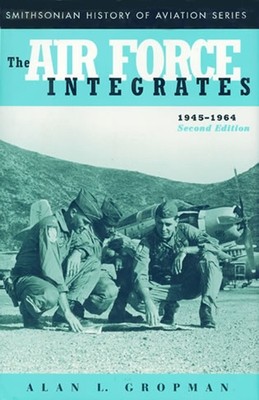
- We will send in 10–14 business days.
- Author: Alan L Gropman
- Publisher: Smithsonian Institution Scholarly Press
- ISBN-10: 1935623559
- ISBN-13: 9781935623557
- Format: 15 x 22.6 x 1.5 cm, softcover
- Language: English
- SAVE -10% with code: EXTRA
The Air Force Integrates, 1945-1964, Second Edition (e-book) (used book) | bookbook.eu
Reviews
Description
On April 5, 1945, more than sixty black officers of the U.S. Army Air Forces were arrested for entering a whites-only club at Freeman Field, Indiana, to protest the rigid segregation and unequal policies under which they and all African American airmen were forced to serve. Termed a mutiny by the white commanders at the base, the incident was one of several racial conflicts during the next four years that helped convince senior officers in the newly independent Air Force that segregation was an inefficient personnel policy. Documenting the racial integration of the Air Force from the end of World War II to the passage of the Civil Rights Act of 1964, Alan L. Gropman contends that the service desegregated itself not for moral or political reasons but to improve military effectiveness. He draws on a range of unpublished records to show that, while proceeding smoothly, Air Force integration initially did little to ensure fair promotion practices or to protect African Americans from off-post discrimination, especially in housing, entertainment, and education. Gropman also outlines the political motivations of President Truman's 1948 Executive Order 9981 for equal opportunity in the military and reviews controversial Kennedy administration initiatives that attempted to place the military at the forefront of civil rights reform. First published in 1977, the book now includes a new preface charting the policy changes that have dramatically increased the numbers of black officers and senior supervisors in the Air Force during the past two decades. Detailing the uneven progress of a major shift in military policy, The Air Force Integrates also illuminates the often pragmatic motivations of those who bring about fundamental social change.
EXTRA 10 % discount with code: EXTRA
The promotion ends in 19d.23:32:35
The discount code is valid when purchasing from 10 €. Discounts do not stack.
- Author: Alan L Gropman
- Publisher: Smithsonian Institution Scholarly Press
- ISBN-10: 1935623559
- ISBN-13: 9781935623557
- Format: 15 x 22.6 x 1.5 cm, softcover
- Language: English English
On April 5, 1945, more than sixty black officers of the U.S. Army Air Forces were arrested for entering a whites-only club at Freeman Field, Indiana, to protest the rigid segregation and unequal policies under which they and all African American airmen were forced to serve. Termed a mutiny by the white commanders at the base, the incident was one of several racial conflicts during the next four years that helped convince senior officers in the newly independent Air Force that segregation was an inefficient personnel policy. Documenting the racial integration of the Air Force from the end of World War II to the passage of the Civil Rights Act of 1964, Alan L. Gropman contends that the service desegregated itself not for moral or political reasons but to improve military effectiveness. He draws on a range of unpublished records to show that, while proceeding smoothly, Air Force integration initially did little to ensure fair promotion practices or to protect African Americans from off-post discrimination, especially in housing, entertainment, and education. Gropman also outlines the political motivations of President Truman's 1948 Executive Order 9981 for equal opportunity in the military and reviews controversial Kennedy administration initiatives that attempted to place the military at the forefront of civil rights reform. First published in 1977, the book now includes a new preface charting the policy changes that have dramatically increased the numbers of black officers and senior supervisors in the Air Force during the past two decades. Detailing the uneven progress of a major shift in military policy, The Air Force Integrates also illuminates the often pragmatic motivations of those who bring about fundamental social change.


Reviews